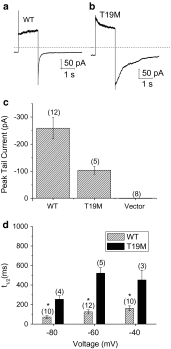The connexin46 mutant, Cx46T19M, causes loss of gap junction function and alters hemi-channel gating
- PMID: 25404239
- PMCID: PMC4300453
- DOI: 10.1007/s00232-014-9752-y
The connexin46 mutant, Cx46T19M, causes loss of gap junction function and alters hemi-channel gating
Abstract
An N-terminal mutant of connexin46 (T19M) alters a highly conserved threonine and has been linked to autosomal dominant cataracts. To study the cellular and functional consequences of substitution of this amino acid, T19M was expressed in Xenopus oocytes and in HeLa cells. Unlike wild-type Cx46, T19M did not induce intercellular conductances in Xenopus oocytes. In transfected HeLa cells, T19M was largely localized within the cytoplasm, with drastically reduced formation of gap junction plaques. Expression of rat T19M was cytotoxic, as evidenced by an almost complete loss of viable cells expressing the mutant protein by 48-72 h following transfection. When incubated in medium containing physiological concentrations of divalent cations, T19M-expressing cells showed increased uptake of DAPI as compared with cells expressing wild-type Cx46, suggesting aberrant connexin hemi-channel activity. Time-lapse and dye uptake studies suggested that T19M hemi-channels had reduced sensitivity to Ca(2+). Whole cell patch clamp studies of single transfected HeLa cells demonstrated that rat T19M formed functional hemi-channels with altered voltage-dependent gating. These data suggest that T19M causes cataracts by loss of gap junctional channel function and abnormally increased hemi-channel activity. Furthermore, they implicate this conserved threonine in both gap junction plaque formation and channel/hemi-channel gating in Cx46.
Figures








Similar articles
-
Properties of two cataract-associated mutations located in the NH2 terminus of connexin 46.Am J Physiol Cell Physiol. 2013 May 1;304(9):C823-32. doi: 10.1152/ajpcell.00344.2012. Epub 2013 Jan 9. Am J Physiol Cell Physiol. 2013. PMID: 23302783 Free PMC article.
-
The cataract-inducing S50P mutation in Cx50 dominantly alters the channel gating of wild-type lens connexins.J Cell Sci. 2007 Dec 1;120(Pt 23):4107-16. doi: 10.1242/jcs.012237. Epub 2007 Nov 14. J Cell Sci. 2007. PMID: 18003700
-
Connexin46 mutations linked to congenital cataract show loss of gap junction channel function.Am J Physiol Cell Physiol. 2000 Sep;279(3):C596-602. doi: 10.1152/ajpcell.2000.279.3.C596. Am J Physiol Cell Physiol. 2000. PMID: 10942709
-
Calmodulin-Cork Model of Gap Junction Channel Gating-One Molecule, Two Mechanisms.Int J Mol Sci. 2020 Jul 13;21(14):4938. doi: 10.3390/ijms21144938. Int J Mol Sci. 2020. PMID: 32668628 Free PMC article. Review.
-
Calmodulin-Connexin Partnership in Gap Junction Channel Regulation-Calmodulin-Cork Gating Model.Int J Mol Sci. 2021 Dec 2;22(23):13055. doi: 10.3390/ijms222313055. Int J Mol Sci. 2021. PMID: 34884859 Free PMC article. Review.
Cited by
-
Whole-genome sequencing reveals a recurrent missense mutation in the Connexin 46 (GJA3) gene causing autosomal-dominant lamellar cataract.Eye (Lond). 2018 May 1;32(10):1661-1668. doi: 10.1038/s41433-018-0154-8. Eye (Lond). 2018. PMID: 29934635 Free PMC article.
-
Delineation of Novel Autosomal Recessive Mutation in GJA3 and Autosomal Dominant Mutations in GJA8 in Pakistani Congenital Cataract Families.Genes (Basel). 2018 Feb 20;9(2):112. doi: 10.3390/genes9020112. Genes (Basel). 2018. PMID: 29461512 Free PMC article.
-
Increased Hemichannel Activity Displayed by a Connexin43 Mutation Causing a Familial Connexinopathy Exhibiting Hypotrichosis with Follicular Keratosis and Hyperostosis.Int J Mol Sci. 2023 Jan 22;24(3):2222. doi: 10.3390/ijms24032222. Int J Mol Sci. 2023. PMID: 36768546 Free PMC article.
-
Identification of a novel GJA3 mutation in a large Chinese family with congenital cataract using targeted exome sequencing.PLoS One. 2017 Sep 6;12(9):e0184440. doi: 10.1371/journal.pone.0184440. eCollection 2017. PLoS One. 2017. PMID: 28877251 Free PMC article.
-
Connexin Mutations and Hereditary Diseases.Int J Mol Sci. 2022 Apr 12;23(8):4255. doi: 10.3390/ijms23084255. Int J Mol Sci. 2022. PMID: 35457072 Free PMC article. Review.
References
-
- Arora A, Minogue PJ, Liu X, Reddy MA, Ainsworth JR, Bhattacharya SS, Webster AR, Hunt DM, Ebihara L, Moore AT, Beyer EC, Berthoud VM. A novel GJA8 mutation is associated with autosomal dominant lamellar pulverulent cataract: further evidence for gap junction dysfunction in human cataract. J Med Genet. 2006;43:e2. doi: 10.1136/jmg.2005.034108. - DOI - PMC - PubMed
-
- Beyer EC, Berthoud VM. The family of connexin genes. In: Harris AL, Locke D, editors. Connexins: a guide. New York: Humana Press; 2009. pp. 3–26.
Publication types
MeSH terms
Substances
Supplementary concepts
Grants and funding
LinkOut - more resources
Full Text Sources
Other Literature Sources
Miscellaneous

